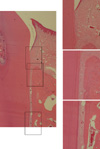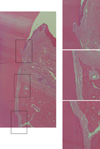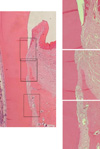1. Karring T, Nyman S, Gottlow J, Laurell L. Development of the biological concept of guided tissue regeneration: animal and human studies. Periodontol 2000. 1993. 1:26–35.

2. Bartold PM, McCulloch CA, Narayanan AS, Pitaru S. Tissue engineering: a new paradigm for periodontal regeneration based on molecular and cell biology. Periodontol 2000. 2000. 24:253–269.

3. Denton GB. The discovery of cementum. J Dent Res. 1939. 18:239. (abstract 6). In Robinson HBG. International Association for Dental Research: Proceedings of the Seventeenth General Meeting Hotel Cleveland, Cleveland, Ohio March 18 and 19, 1939. J Dent Res 1939;18:213-303.
4. Bosshardt DD, Nanci A. Immunodetection of enamel- and cementum-related (bone) proteins at the enamel-free area and cervical portion of the tooth in rat molars. J Bone Miner Res. 1997. 12:367–379.

5. Bosshardt DD, Selvig KA. Dental cementum: the dynamic tissue covering of the root. Periodontol 2000. 1997. 13:41–75.

6. Bosshardt DD. Are cementoblasts a subpopulation of osteoblasts or a unique phenotype? J Dent Res. 2005. 84:390–406.

7. Pitaru S, McCulloch CA, Narayanan SA. Cellular origins and differentiation control mechanisms during periodontal development and wound healing. J Periodontal Res. 1994. 29:81–94.

8. Schroeder HE. Biological problems of regenerative cementogenesis: synthesis and attachment of collagenous matrices on growing and established root surfaces. Int Rev Cytol. 1992. 142:1–59.

9. Gottlow J, Karring T, Nyman S. Guided tissue regeneration following treatment of recession-type defects in the monkey. J Periodontol. 1990. 61:680–685.

10. Gottlow J, Nyman S, Karring T, Lindhe J. New attachment formation as the result of controlled tissue regeneration. J Clin Periodontol. 1984. 11:494–503.

11. Lindskog S, Blomlof L. Quality of periodontal healing. IV: Enzyme histochemical evidence for an osteoblast origin of reparative cementum. Swed Dent J. 1994. 18:181–189.
12. Cochran DL, Jones A, Heijl L, Mellonig JT, Schoolfield J, King GN. Periodontal regeneration with a combination of enamel matrix proteins and autogenous bone grafting. J Periodontol. 2003. 74:1269–1281.

13. Donos N, Sculean A, Glavind L, Reich E, Karring T. Wound healing of degree III furcation involvements following guided tissue regeneration and/or Emdogain. A histologic study. J Clin Periodontol. 2003. 30:1061–1068.

14. Lindskog S, Blomlof L. Mineralized tissue-formation in periodontal wound healing. J Clin Periodontol. 1992. 19:741–748.

15. Araujo M, Berglundh T, Lindhe J. The periodontal tissues in healed degree III furcation defects: an experimental study in dogs. J Clin Periodontol. 1996. 23:532–541.

16. Araujo MG, Berglundh T, Lindhe J. On the dynamics of periodontal tissue formation in degree III furcation defects: an experimental study in dogs. J Clin Periodontol. 1997. 24:738–746.

17. Araujo MG, Berglundh T, Lindhe J. GTR treatment of degree III furcation defects with 2 different resorbable barriers: an experimental study in dogs. J Clin Periodontol. 1998. 25:253–259.

18. Schupbach P, Gaberthuel T, Lutz F, Guggenheim B. Periodontal repair or regeneration: structures of different types of new attachment. J Periodontal Res. 1993. 28:281–293.

19. Graziani F, Laurell L, Tonetti M, Gottlow J, Berglundh T. Periodontal wound healing following GTR therapy of dehiscence-type defects in the monkey: short-, medium- and long-term healing. J Clin Periodontol. 2005. 32:905–914.

20. Kim CS, Choi SH, Chai JK, Cho KS, Moon IS, Wikesjo UM, et al. Periodontal repair in surgically created intrabony defects in dogs: influence of the number of bone walls on healing response. J Periodontol. 2004. 75:229–235.

21. Yamamoto T, Domon T, Takahashi S, Wakita M. Cellular cementogenesis in rat molars: the role of cementoblasts in the deposition of intrinsic matrix fibers of cementum proper. Anat Embryol (Berl). 1996. 193:495–500.

22. Schroeder HE. Human cellular mixed stratified cementum: a tissue with alternating layers of acellular extrinsicand cellular intrinsic fiber cementum. Schweiz Monatsschr Zahnmed. 1993. 103:550–560.
23. Hammarstrom L, Heijl L, Gestrelius S. Periodontal regeneration in a buccal dehiscence model in monkeys after application of enamel matrix proteins. J Clin Periodontol. 1997. 24:669–677.

24. Sculean A, Donos N, Brecx M, Reich E, Karring T. Treatment of intrabony defects with guided tissue regeneration and enamel-matrix-proteins: an experimental study in monkeys. J Clin Periodontol. 2000. 27:466–472.

25. Listgarten MA. Electron microscopic study of the junction between surgically denuded root surfaces and regenerated periodontal tissues. J Periodontal Res. 1972. 7:68–90.

26. Kostopoulos L, Karring T. Susceptibility of GTR-regenerated periodontal attachment to ligature-induced periodontitis. J Clin Periodontol. 2004. 31:336–340.

27. Bosshardt DD, Sculean A, Windisch P, Pjetursson BE, Lang NP. Effects of enamel matrix proteins on tissue formation along the roots of human teeth. J Periodontal Res. 2005. 40:158–167.

28. Wikesjo UM, Nilveus R. Periodontal repair in dogs. Healing patterns in large circumferential periodontal defects. J Clin Periodontol. 1991. 18:49–59.

29. Frank R, Fiore-Donno G, Cimasoni G, Matter J. Ultrastructural study of epithelial and connective gingival reattachment in man. J Periodontol. 1974. 45:626–635.





 PDF
PDF ePub
ePub Citation
Citation Print
Print











 XML Download
XML Download